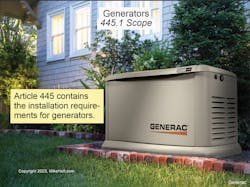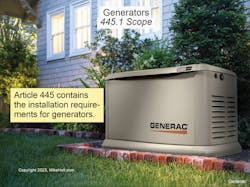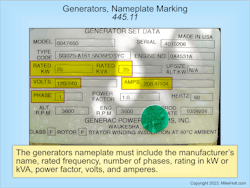You can think of a generator as a motor that runs in reverse. Instead of supplying electricity to a stator to make the rotor spin, a generator is mechanically driven to make its rotor spin to supply electricity from its stator. A motor converts electricity into mechanical motion while a generator converts mechanical motion into electricity. In mounting, a motor is aligned with its load, but a generator is aligned with its driver (which is called the prime mover).
The prime mover may be an engine, such as one that runs on natural gas or diesel. It can be a steam turbine, such as those used in plants that burn coal or split nuclear fuel (fission). It can also be a hydro turbine, such as what is used in the Hoover Dam.
A generator power system can be stand alone or it can be interconnected with another source. Generators can be portable or stationary. They can be used for backup power or emergency standby power. A backup power generator comes up to speed slowly and can run for a long time. An emergency standby power generator comes up to speed rapidly — but the cost of being able to do that is it can’t run for a long time.
In most facilities with a generator room, the space is fire suppression protected and usually has auto-closing doors that seal the room after a short delay for personnel to exit once the alarm is triggered. Special entry requirements apply, as do other special safety considerations. Rooms that contain large diesel generators typically have a large sound suppression system similar to a car muffler (but much larger) on the exhaust. Fuel is also stored on site, typically with a smaller day tank in an adjacent room.
Article 445 contains the electrical installation and other requirements for generators. These rules include such things as where generators can be installed, nameplate markings, conductor ampacity, and disconnect requirements (Fig. 1).
But if a generator is basically a motor that runs in reverse, why not just apply Art. 430 in reverse when you have a generator? When you start a motor, you have stress on the electrical supply due to the inrush current. When you start a generator, it is the electrical supply — and it doesn’t create inrush current. This difference is why Art. 430 is the longest Article, and Art. 445 is among the shortest.
Other articles
Generators, associated wiring, and equipment must be installed per the following requirements depending on their use:
- Fire Pumps, Art. 695. Because it is essential to preserving human life in the event of a fire, a fire pump must run even if you have to burn it up in the process (you don’t protect it from overload). If it’s supplied by a generator, that generator must also be sacrificed, if necessary, to keep that pump running as long as possible.
- Emergency Systems, Art. 700. An emergency systems generator supplies electricity for power and/or illumination when the normal source of electricity is interrupted. As the name implies, these systems are for emergencies — not for sustained operations. Informational Note 1 under Sec. 700.1 provides more detail about this. An example is a system that provides power to elevators and fire pumps when some event causes the building to lose power.
- Legally Required Standby Systems, Art. 701. Public safety is often a reason for a standby system to be required by law at a particular facility. For example, a chemical plant might be required to have a standby system to provide an orderly shutdown instead of an accidental release. Hospitals are also examples of facilities with legally required standby systems.
- Optional Standby Systems, Art. 702. A glass plant is a good example of a facility that uses standby systems; if the glass cools in the process piping, you have a very expensive problem. Data centers also have standby systems. On some sites, there are two types of generators; one that is up to speed in a minute or so and one that takes a longer time to be ready to assume the load as long as needed.
- Interconnected Electric Power Production Sources, Art. 705. Many residential generators are connected in parallel with the utility. This arrangement is no stranger to industrial or commercial applications, either. It’s often used during peak load charge hours to stay below the peak load penalty charge the utility would impose.
Listing and marking
Stationary generators rated 600V and less must be listed [Sec. 445.6].
Exception: One-of-a-kind or custom manufactured generators are permitted to be field labeled by a field evaluation body.
Generators must have a nameplate giving the manufacturer’s name, the rated frequency, number of phases, rating in kilowatts or kilovolt-amperes, power factor, and the volts and amperes corresponding to the rating [Sec. 445.11] (Fig. 2).
Conductor ampacity
The ampacity of the conductors from the generator winding output terminals to the first overcurrent protective device must be not less than 115% of the nameplate current rating of the generator [Sec. 445.13(A)].
Since the overcurrent protective device is typically part of the generator, this 115% rule applies to the generator manufacturer, not the field installer. However, checking this no later than in the receiving process is very important.
Waiting until after the generator has been transported to the site, set in place, and connected not only means significant rework but also a huge loss in productivity while the assigned crews face what is likely to be an extended work stoppage. If possible, have a qualified person inspect the generator (with a factory rep helping) before the generator is shipped. This method can ensure items normally verified in receiving (or during installation) are verified at the most efficient verification point of the project.
Conductors from the load side of the generator (feeder conductors) are sized to the generator’s overcurrent protective device rating per Sec. 240.4.
Example
Question: What size feeder conductor is required from a 100A overcurrent protective device on a 20kW, 120/240V, single-phase generator to the transfer switch if the terminals are rated 75°C (Fig. 3)?
(a) 4 AWG
(b) 3 AWG
(c) 2 AWG
(d) 1 AWG
Solution: 3 AWG is rated 100A at 75°C [Sec. 110.14(C)(1)(a)(3) and Table 310.16].
Answer: (b) 3 AWG
The generator’s feeder neutral must be sized to carry the maximum unbalanced current as determined by Sec. 220.61.
Disconnecting means and emergency shutdown
Generators, other than cord- and plug-connected portable generators, must have one or more disconnecting means capable of being locked in the open position per Sec. 110.25 [Sec. 445.18(A)].
A rule that’s new with the 2023 revision allows the disconnecting means to be located behind a hinged cover, door, or enclosure. Another new rule applies if the disconnect is located within the generator. In that case, a field-applied label conforming to Sec. 110.21(B) must be provided, and it must indicate the location of the generator disconnect.
Generators must have provisions to shut down the prime mover [445.19(A)]. The means of shutdown must comply with both of the following:
(1) Be equipped with provisions to disable all prime mover start control circuits to render the prime mover incapable of starting.
(2) Initiate a shutdown mechanism that requires a mechanical reset.
The provisions to shut down the prime mover can satisfy the requirements of Sec. 445.18(A) if the shutdown device is capable of being locked in the open position per Sec. 110.25.
For other than one- and two-family dwelling units, generators with a rating greater than 15kW must have a remote emergency stop switch to shut down the prime mover [Sec. 445.19(B)]. The remote emergency stop switch must be outside the equipment room or generator enclosure and must also meet the requirements of Sec. 445.18(B)(1) and (B)(2). It can be mounted on the exterior of the generator enclosure.
For one- and two-family dwelling units, an emergency shutdown device must be located outside the dwelling unit at a readily accessible location [Sec. 445.19(C)]. Cord- and plug-connected portable generators are excluded from this requirement.
More to the job
Article 445 doesn’t cover everything you need to know for a Code-compliant generator installation. You must apply other Articles from Chapters 1 through 4. It gets tricky when you consider how to correctly apply Parts II and III of Art. 250 because the rules differ depending on the type of transfer equipment installed. For example, if your transfer switch switches the grounded conductor, the generator must be grounded as a separately derived system per Sec. 250.30. This topic could make for a multi-part article series.
These materials are provided by Mike Holt Enterprises in Leesburg, Fla. To view Code training materials offered by this company, visit www.mikeholt.com/code.
About the Author

Mike Holt
Mike Holt is the owner of Mike Holt Enterprises (www.MikeHolt.com), one of the largest electrical publishers in the United States. He earned a master's degree in the Business Administration Program (MBA) from the University of Miami. He earned his reputation as a National Electrical Code (NEC) expert by working his way up through the electrical trade. Formally a construction editor for two different trade publications, Mike started his career as an apprentice electrician and eventually became a master electrician, an electrical inspector, a contractor, and an educator. Mike has taught more than 1,000 classes on 30 different electrical-related subjects — ranging from alarm installations to exam preparation and voltage drop calculations. He continues to produce seminars, videos, books, and online training for the trade as well as contribute monthly Code content to EC&M magazine.




